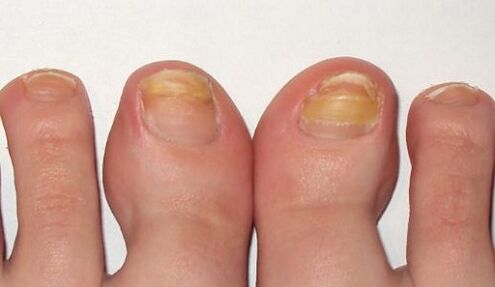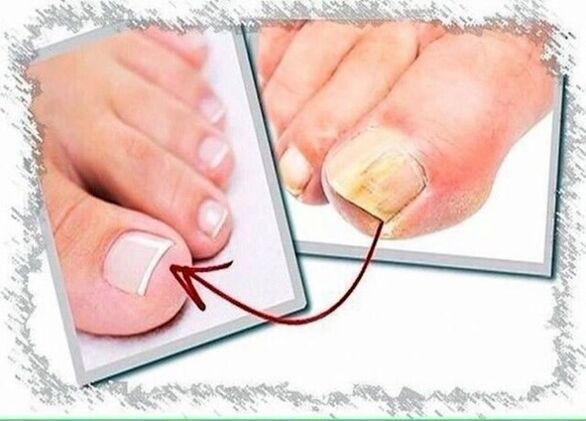Nail fungus (nail mycosis) is an infectious disease that affects every 5 adults on our planet. Infection occurs very quickly and occurs through pathogenic fungi. You can "get" the infection if you wear someone else's shoes or neglect hygiene rules, as well as when visiting swimming pools, saunas, etc. Diabetes, poor circulation in the feet, low immunity, damaged nails, excess weight and excessive sweating can contribute to the appearance of toenail fungus. How to determine nail fungus, what symptoms signal the appearance of the disease? We will talk about it in this article.
Mycosis of the nails usually appears on the feet, less often on the hands, but it can move from the foot to the hand and from one finger to another. This disease may seem mild, but it is very "survivable", causing physical and psychological discomfort. Treatment of fungus is a very laborious and long process, if the disease is not detected in time or the symptoms are ignored, then serious violations can occur: the fungus quickly strengthens in the nails and penetrates the internal organs, where it can cause serious damage. Therefore, to diagnose and recognize toenail fungus in time, it is necessary to recognize the first signs of toenail fungus. What are they?
Foot mold signs
As a rule, there are no significant changes in the initial stages, but if you miss the moment, then diagnosis and treatment will become a problem. So how do you spot nail fungus? Signs or symptoms of nail fungus include the following:
- Changing the structure of the nail. The nail changes color (yellows), becomes brittle, rough and cloudy.
- Painful sensations in the lesion. The site of the appearance of the fungus hurts in contact with shoes.
- Itching and burning in the skin. The skin near the infected nail becomes red and itchy.
- Falling off the nail. In advanced stages, nails infected with the fungus can peel off.
There are 4 stages of nail fungus:
- The initial stage of nail fungus is almost never diagnosed (only medically). Barely visible white lines appear on the nail plate, which indicates the presence of a fungus.
- The second is characterized by a change in the appearance of the nail plate (you can recognize it yourself). The nail turns yellow, becomes cloudy and crumbles.
- The third is manifested in a visible deformation of the nail, and sometimes its partial detachment. Also, the skin around the fingers starts to itch, burn and peel.
- The fourth is the busiest. The affected skin begins to break out, become wet and, if not treated, non-healing sores appear.
Causes of fungus

So why does the fungus appear? Microorganisms called fungi (dermatophiles) are responsible for fungal damage to the body. And a certain environment allows them to multiply, so the reasons for the appearance of fungi include moisture and heat, which are formed as a result of wearing shoes that do not allow air to pass, or synthetic socks, and also if you do not wipe themdry feet after washing, damage to the nail - when the nail plate is cut under the root, wearing tight shoes, which only contributes to the weakening of the nail, such as acrylic or gel varnishes.
So what do fungal nails look like? They are yellow, have lost their luster, crumbling and partially exfoliating. If you have seen all these symptoms of nail fungus or some of them, you should immediately consult a specialist, as self-medication is simply a waste of precious time.
By itself, nail fungus will not go away, it will attack your body step by step, weakening it. This is why one of the main and most important symptoms of toenail fungus is its systemic nature.
Treatment of the causes of nail fungus
So, the first symptoms are recognized and you have come to the doctor. A dermatologist or mycologist must first determine the type and extent of the disease (taking a sample of the affected tissue) and make a diagnosis and then prescribe treatment. According to the degree of damage to the nail, normotrophic mycosis is distinguished (when the color of the nail changes), hypertrophic mycosis (the change in color is accompanied by blurring of the nail and its thickness), atrophic mycosis (in addition to the change in color and deformation, the nail crumbles and detacheshis).
Treatment begins with local preparations - these are ointments, patches and creams. Most often they are used to restore skin affected by fungi. Antifungal varnishes are used for the treatment of nails, the principle of their action is based on deep penetration into the nail plate and the elimination of fungal pathogens. On the surface of the nail, these drugs form a film that prevents the attack of a new infection.
In severe cases of the disease and the ineffectiveness of treatment with local drugs, the dermatologist prescribes antifungal tablets. It is worth noting that in terms of their spectrum of action, they have a very serious effect on the body and have a number of side effects. When prescribing oral tablets and while taking them, it is necessary to conduct tests so that the doctor can monitor the course of treatment and their effect on the body.
There are also cases when specialists prescribe local drugs along with antifungal tablets. This happens in the most severe forms of the disease or in patients of mature age, in which the recovery process is slower. As a result of such therapy, the course of treatment is significantly reduced.
Folk remedies against fungi
Along with drug treatment, traditional medicine is also widely used in the fight against fungi.
Improper treatment is a step towards worsening the disease! It should be remembered that folk remedies will not cure nail fungus, but can only alleviate the condition and alleviate the symptoms. They can be used as additional support for medical treatment.
No treatment (drug or folk) will be effective if you do not follow certain rules of hygiene, this is what the tips for the prevention of fungus consist of.
Prevention of mycosis of the nails

Preventing nail fungus is a fairly simple task, given some standard hygiene requirements that everyone can and should follow:
- Wear socks or tights made of natural fabric and change them every day, and if your feet get wet during the day (several times a day), you should wash them, wipe them and change your socks to dry ones.
- Change your shoes often. If you wear the same shoes day after day, always check (before going out) to see if they are dry from the previous walk. Remember that a moist environment promotes the formation of fungi.
- When you visit a manicurist and pedicurist, make sure the tools are in the right shape and condition. Feel free to ask a specialist to disinfect all equipment.
- Low immunity is a prerequisite for the appearance of a mold. Enrich your diet with healthy foods: eat more fruits and vegetables - they are rich in vitamins, do not be lazy to eat garlic and nuts.
- Apply antiseptics. The most common among them is tea tree oil (a natural antiseptic), they can be used to treat nails and the skin around them.
- Use only your own personal hygiene products, as shared items are a sure way for fungus. You must have your own toiletries (towel, brush, comb, scissors); Also, when you go to public places (bathroom, swimming pool, sauna, gym), you should only use your shoes (even in the shower).
Prevention is the easiest way to avoid fungus! By regularly following the simple rules (above), you will not have to get rid of "stubborn" nail mycosis for a long time and painfully. Personal hygiene: the key to health.
Summarizing
So how to determine nail fungus? You should study the appearance of the nails, as well as pay attention to the symptoms and signs of the fungus. If, however, nail mycosis is present, it is urgent to contact a dermatologist or mycologist, but do not self-medicate, so as not to waste precious time. To treat fungus only with drugs (under the supervision of a doctor), folk remedies can be used as an adjunctive therapy. And most importantly: you must follow the rules of personal hygiene (no matter how much you think that these are small things and some of them can be neglected) in order to avoid such an unpleasant disease as nail fungus and not to facewith him.















